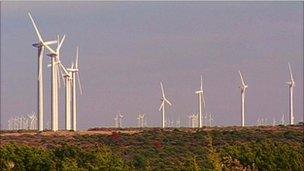The world's largest wind farms
- Published
David Shukman explores Sweetwater's giant windfarm
With the UN climate conference about to open in Cancun, BBC environment correspondent David Shukman samples opinion in Texas, home to the world's largest wind farms.
Driving out of the dusty little town of Sweetwater, the climb up to the High Plain reveals a few small clumps of wind turbines, the odd row of them, nothing special.
I've seen plenty of wind farms and I wonder if I'm the victim of Texan bragging: the claim to host five of the largest wind installations in the world.
But the higher I get, the further I can see and soon there's an extraordinary vista: ridge after rolling ridge crowded with thickets of turbines.
This dry, treeless landscape has suddenly sprouted whole forests of stark white towers stretching into the distance, the giant blades gently circling in the breeze.
It's green energy on an industrial scale that any environmentalist would dream of - and it's all come about in a frenetic rush in the past decade.
As we start our filming, a pickup truck bounces along a track towards us.
"Howdy, howdy," the driver calls out. He introduces himself as Jimmy Hileman, an oil worker who also farms between shifts out on the rigs. I ask what he makes of the turbines.
"It's beautiful country... and I hate to see the pollution for the eye but it's great for the local economy... and it's great for our clean energy economy. I'm up for it."
Big bucks
The numbers are staggering. This one county, Nolan County, hosts no fewer than 1,400 turbines. Texas has as many as 6,000 overall. Combined output: something like 9,000MW, roughly the output of nine power stations.
At first sight, you might think this couldn't be a clearer example of the United States tackling climate change.

Wind farms are popular, but talk of climate change may not be
But the Mayor of Sweetwater, Greg Wortham, puts me right on that. Support for wind energy, he explains, is based on the jobs and wealth generated.
A single wind turbine can earn a landowner $10,000 a year. A field of cotton can more than double its revenue if turbines are planted.
It's popular - but whatever you do, don't mention the climate, say Mr Wortham. It's too polarising.
"Carbon footprint, green, climate change - those issues are so charged in the US that really the fact that this produces energy and revenue… and other things we say we're for, there are just certain labels that cause people to form into groups.
"You know, we're against you because you're for this or that."
So there's a paradox: the people at the heart of one of the largest ever booms in clean energy see plenty of benefits - except the one of avoiding greenhouse gases.
Think how often pictures of wind turbines are used to portray efforts to tackle climate change. And here, where they have more of them than most countries, polite conversation steers well away from subjects like carbon dioxide.
Oil magnate
It's a highly sensitive time for climate policy in the US. Just two years after Barack Obama was elected to the presidency promising to aid "a planet in peril", his original hopes for action have faded.
A bill to limit emissions scraped through the House of Representatives last year but died in the US Senate this summer, and now the House is controlled by the Republicans, many of them hostile to the whole notion of global warming.

Mr Pickens (L) wants to use natural gas to power America's trucks
So I travel to the gleaming towers of Dallas to meet one of the largest investors in wind power to see what he makes of it all.
T Boone Pickens is a larger-than-life Texan billionaire - a geologist by training, he's an oil man, a Republican who's motivated by the need to see the US cut its dependence on foreign energy.
His offices are adorned with photographs of Mr Pickens with Ronald Reagan, George W Bush, Dick Cheney, and the Queen. Paintings depict oil pioneers on horseback in the boomtowns of a century ago.
At 82, he's as active as ever, pushing his "Pickens Plan" to use natural gas to power America's eight million large trucks.
What does he think of the science of climate change?
"I do think we have hurried some things along, maybe they wouldn't have happened, maybe they would," he says.
And what about global warming and how it's viewed in the US?
"They tell me the ice cap is deteriorating and the polar bear is in trouble - I believe that to be true.
"But you don't get everyone to worry about a polar bear or the icecap - their deal is more at home, it's around the table, it's with their families."
'Belly of the beast'
So where does that leave environmental campaigners?
Their hope had been that President Obama would persuade Congress to agree on new legislation to control greenhouse gases - a "cap and trade" system - and then bring the US into a future global post-Kyoto agreement.
I meet members of the Sierra Club, one of America's largest campaign groups.
In Texas, one of the greatest battles is over the state's coal-burning power stations - and plans for new ones. Texas is the country's largest emitter of greenhouse gas and the state administration is in constant dispute with the Environmental Protection Agency.
I suggest that this isn't the most comfortable place to be a green campaigner.
Eva Hernandez laughs: "I wouldn't say it's an easy road. We're in the belly of the beast.
"It's a big industrial state and our leadership doesn't believe in global warming They deny it's a problem.
"So what we have to do is continue to look at the science, and educate people."
But controversy over the science - with the "Climategate" e-mails - has combined with the recession and fears of rising energy bills to muddy the waters.
I ask a range of people the same question: could you ever imagine the US joining a global treaty on climate change? No-one thinks so.
The march of wind turbines may continue across the plains of Texas - and other alternatives like solar may well expand rapidly, too - but the case for them will not involve the word "climate".
In the same field where a dozen turbines stand, "nodding donkey" pumps draw oil from the rocks below.
The rushing whoosh of the turbine blades mixes with a steady, rhythmic creak from the oil machine. I wonder, which sound will be heard longest?